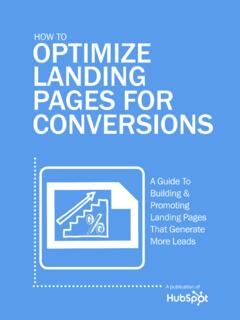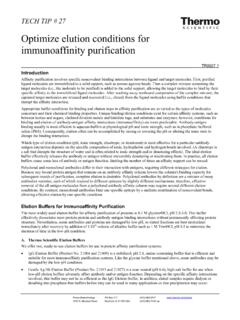Transcription of Predictive maintenance and the smart factory
1 Predictive maintenance connects machines to reliability professionals through the power of the smart factoryPredictive maintenance and the smart factoryPredictive maintenance and the smart factory02 Traditionally, maintenance professionals have combined many techniques, both quantitative and qualitative, in an effort to predict impending failures and mitigate downtime in their manufacturing facilities. Predictive maintenance offers them the potential to optimize maintenance tasks in real time, maximizing the useful life of their equipment while still avoiding disruption to and reliability professionals in the manufacturing industry face a number of challenges, but the goal of any maintenance organization is always the same: to maximize asset availability.
2 In this article, we ll focus on fixed assets, the machines on the shop floor that turn raw material into finished goods. Today, poor maintenance strategies can reduce a plant s overall productive capacity by 5 to 20 Recent studies also show that unplanned downtime is costing industrial manufacturers an estimated $50 billion each This begs the question, How often should a machine be taken offline to be serviced? Traditionally, this dilemma forced most maintenance organizations into a trade-off situation where they had to choose between maximizing the useful life of a part at the risk of machine downtime (run-to-failure) or attempting to maximize uptime through early replacement of potentially good parts (time-based preventive maintenance ), which has been demonstrated to be ineffective for most equipment components.
3 Oftentimes, maximum utilization of tooling or machine components can be achieved by running them until they fail. But this can lead to catastrophic machine damage as parts begin to vibrate, overheat, and break, reinforcing the old adage pay me now or pay me later. And, while run-to-failure may be an acceptable approach for some assets, it still needs to be understood that unplanned downtime is almost always more expensive and time consuming to correct. Conversely, you might consider more frequent replacement of parts and servicing of equipment.
4 But this can not only increase replacement costs over time, it can also increase planned downtime and disruption to management presents a similar challenge that can feel like a constant balancing act. With limited budgets, maintenance professionals must evaluate which parts they ll need and when to procure them. If the spare is not on hand or on order when it s needed, the downtime of an asset can be anywhere from days to weeks or even months while waiting for the replacement part. This typically leads to the buildup of spares inventory, which not only ties up working capital, but also increases the risk of excess and obsolescence that erodes the bottom maintenance and the smart factory03 Breaking the tradeoff: Leveraging the power of the smart factoryPredictive maintenance (PdM) aims to break these tradeoffs by empowering companies to maximize the useful life of their parts while avoiding unplanned downtime and minimizing planned downtime.
5 With the advent of Industry for manufacturing, companies are able to leverage new technologies in order to monitor and gain deeper insight into their operations in real time, turning a typical manufacturing facility into a smart factory . Simply put, a smart factory is one equipped with technology that enables machine-to-machine (M2M) and machine-to-human (M2H) communication in tandem with analytical and cognitive technologies so that decisions are made correctly and on time. PdM (which has been around for many years now) utilizes data from various sources, such as critical equipment sensors, enterprise resource planning (ERP) systems, computerized maintenance management systems (CMMS), and production data.
6 smart factory management systems couple this data with advanced prediction models and analytical tools to predict failures and address them proactively. Additionally, over time, new machine-learning technology can increase the accuracy of the Predictive algorithms, leading to even better contrast, traditional preventative maintenance (PM) programs often require very time-consuming, manual data crunching and analysis to gain any real insights from the data being collected. While many have had some success with these strategies , they typically rely heavily on tribal knowledge estimates or require in-depth knowledge and analysis of each individual piece of equipment on an ongoing basis to stay accurate.
7 In line with the maintenance goal of maximizing machine availability, Deloitte identified two main business objectives of all manufacturing companies operating in the Industry era:3 1. Operating the business2. Growing the businessWhile growing the business focuses on top-line growth, operating the business often seeks to cut costs. When you consider the number of person-hours spent performing routine machine inspections that don t lead to any key findings or trigger a work order, in addition to the effort spent firefighting unplanned downtime, the case for PdM starts to become clearer.
8 PdM technologies can pull data from multiple sources and legacy systems in order to provide real-time advanced insights, allowing computer systems to do the legwork so maintenance managers can deploy their resources more efficiently and effectively. Getting to Predictive maintenance : An exploration of the technologiesMaintenance organizations across industries are, by design or default, at different stages of maturity. Some may be running scheduled maintenance checks based on estimates or OEM recommendations, while others may utilize statistics-based programs individually tailored to each fixed asset.
9 Still, others particularly in the aerospace and energy sectors are already employing continuous monitoring technologies of their assets, but may only be monitoring the outputs of the data, rather than leveraging advanced Predictive models. As with anything, there are steps to take on the journey toward reliability optimization, beginning with some of the basics of preventive maintenance and reliability-centered maintenance , while simultaneously piloting PdM with one or two well-suited assets. Prime assets for one of these pilots should be highly integral to operations and must fail with some regularity in order to create baseline Predictive , the idea of PdM sounds enticing.
10 But how does it work? Many of the technologies that make up a smart factory are not necessarily new, but have become much more affordable, more robust, more advanced, and integrated for business use. Computing, storage, and network bandwidth all are now available at fractions of the cost compared to just 20 years ago,4 making piloting and scaling financially s explore some of the technologies that make up a smart factory and make PdM maintenance and the smart factory04 Internet of ThingsThe Internet of Things (IoT) is perhaps the biggest piece of the PdM puzzle.
















